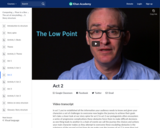
Overview of Act 2.
- Subject:
- Applied Science
- Arts and Humanities
- Computer Science
- Graphic Arts
- Material Type:
- Lesson
- Provider:
- Khan Academy
- Provider Set:
- Pixar
- Author:
- Disney Pixar
- Khan Academy
- Date Added:
- 07/14/2021


Overview of Act 2.
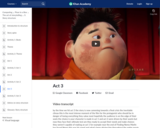
Introduction to Act 3.

The material in this lesson will help students become aware of the warning signs of financial difficulties. When difficulties arise, students should first contact their creditors. Next, efforts should be made to revise spending patterns. In addition, assistance from a Credit Counseling service agencies might be considered. What if these actions do not help?

In Round 1, students learn to allocate their "20 bean salary" according to which options they want to spend their beans on. Round 2 forces the students to reduce their salary to 13 beans and make decisions about where they should make their "cuts". Round 3 includes some "life happens" challenges that allow students to make more decisions on where to move the beans in order to deal with the situations. This activity completes with some reflection questions on how this activity relates to budgeting with real income.

What cognitive styles do you use to interact with technology? PRE-REQ: https://www.oercommons.org/courseware/lesson/87536 LAST UPDATE: Changed title

In this Case Study Activity, students will take on the role of a credit counselor to assist a borrower who finds himself in serious financial distress. Several options will be presented, and students will identify pros and cons of each approach and choose a path forward.

Managing debt loads can be very difficult and overwhelming at times. Hiding from debt and avoiding the problem, will only make the situation worse. This activity includes mini case studies on how to handle various debt problems so that the students can take control of their debt and move forward to a better financial future.
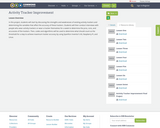
In this project, students will start by discussing the strengths and weaknesses of existing activity trackers and determining the variables that affect the accuracy of these trackers. Students will then conduct interviews with people who wear activity trackers or wear a tracker themselves for a week to determine the pros, cons, and accuracies of the trackers. Then, codes and algorithms will be used to determine what should count as the threshold for a step to achieve maximum tracker accuracy by using Sparkfun Inventor's Kit, Raspberry Pi, and Linux.

This activity is to help students be creative with some of the content they learn in Financial Literacy. Students will learn about taxes and then take it an extra step by creating a short film about what they learned. This can be used to help other students learn more about the complex tax system. Students can use a classroom video camera or their own device to record and edit.

This slide deck is a collection of activities that can be integrated into middle school or high school English Language Arts or Social Studies units as a way of "adding Media Literacy flavor" to what you're already doing.

Step-by-step instructions on adding a resource to a hub using lesson builder.
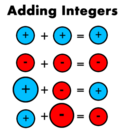
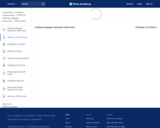
An overview of Adding an event listener
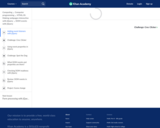
Learn how to add event listeners in jQuery so that your JavaScript can respond to events on the page, like when a user clicks a button or drags an image.

As inflation raises the overall price level in an economy, the purchasing power of the dollar decreases and both borrowing and lending costs increase. The January 2023 issue of Page One Economics® discusses how price indexes can be used to transform nominal wages and interest rates into real, or inflation-adjusted, values.

Goal Setting
Students can identify differences between long- and short-term goals and the importance of setting them.
S.M.A.R.T. Goals
Students can build goals that are specific, measurable, attainable, relevant, and timely.
Task Analysis
Students can break down their goals into smaller tasks and create a plan using these tasks that will enable them to reach their goals.
Time Management and Scheduling
Students can schedule their time for the week and follow those schedules to work toward their goals.

General James Clapper, former United States Director of National Intelligence and the National Geospatial-Intelligence Agency (NGA), once said \everything happens somewhere.\" He stressed that there are aspects of time and place to every intelligence problem. In this course, you will examine how time and place work with general intelligence techniques to create geospatial intelligence. You will learn and apply critical thinking skills, structured analytical techniques, and other intelligence methods in a geospatial context. You'll also learn how to reduce personal and organizational bias by conducting an Analysis of Competing Hypotheses, by R. Heuer, a 45-year veteran of the CIA. As a result, you will be better prepared for the world of geospatial intelligence analysis."

So now that we’ve built and programmed our very own CPU, we’re going to take a step back and look at how CPU speeds have rapidly increased from just a few cycles per second to gigahertz! Some of that improvement, of course, has come from faster and more efficient transistors, but a number hardware designs have been implemented to boost performance. And you’ve probably heard or read about a lot of these - they’re the buzz words attached to just about every new CPU release - terms like instruction pipelining, cache, FLOPS, superscalar, branch prediction, multi-core processors, and even super computers! These designs are pretty complicated, but the fundamental concepts behind them are not. So bear with us as we introduce a lot of new terminology including what might just be the best computer science term of all time: the dirty bit. Let us explain.

Students will create an advertisement promoting their chosen form of advertising, including advantages and disadvantages of their form of advertising. These should then be presented to the class to teach the class about their form.

Consumers see or hear thousands of advertisements each day. The April 2017 issue of Page One Economics: Focus on Finance reviews advertising history and strategies ads use to create demand and influence consumer tastes and preferences.